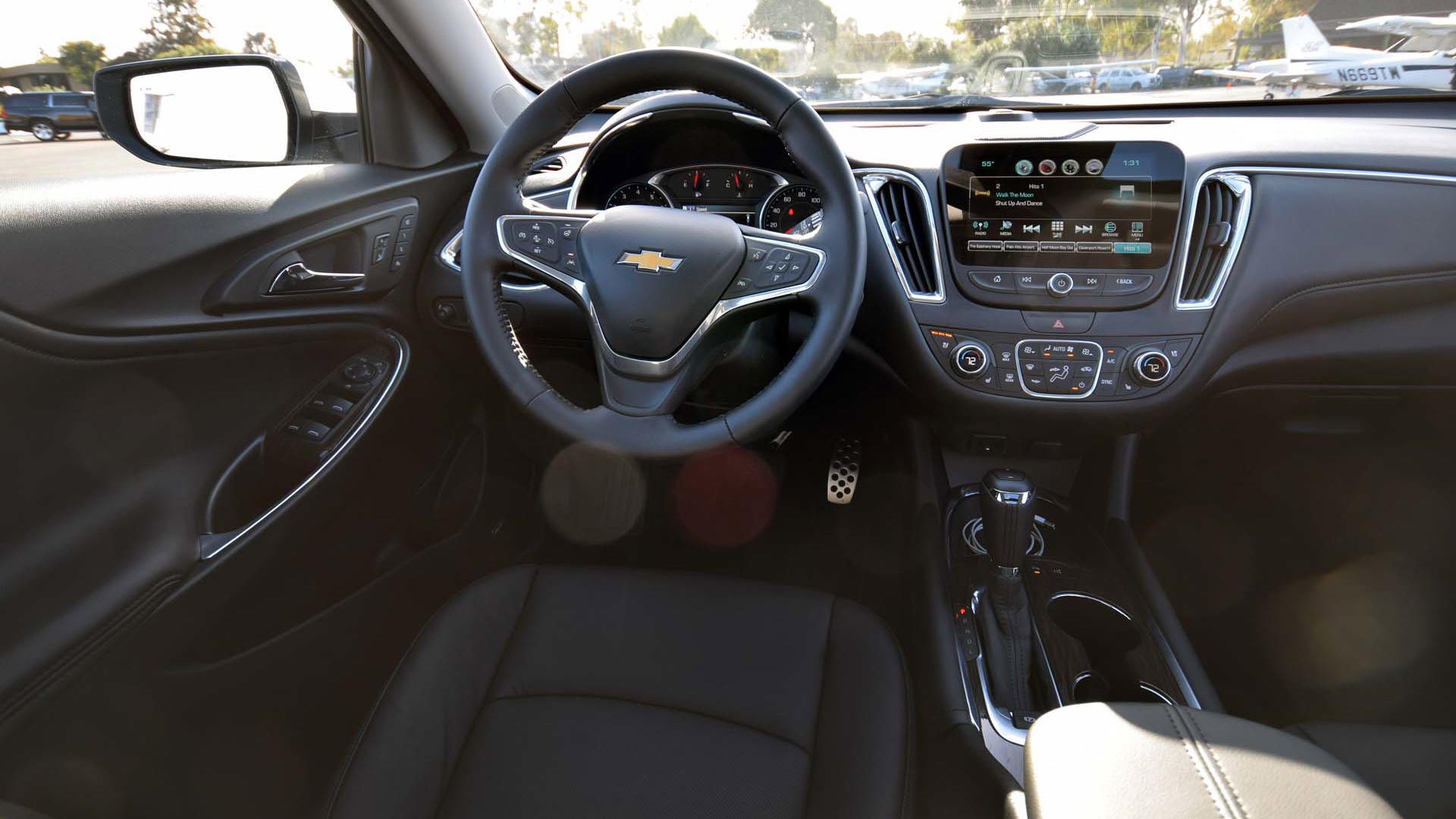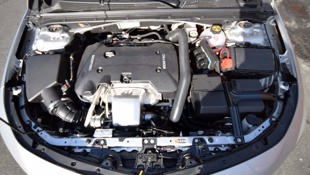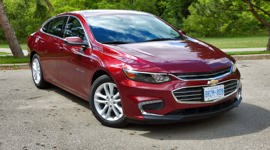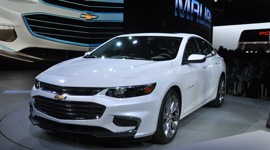Palo Alto, CA – There’s a polish to it. A refinement. A sensation of fine-tuning and attention to dynamic detail that stands out in the 2016 Chevrolet Malibu. The new-for-2016 version of Chevrolet’s Camry and Accord fighter feels honed. Dialed in. Calibrated.
Whip it through a corner at a good clip. You just steer, and the Malibu follows your orders, takes a set, doesn’t stumble or hesitate or wallow around like an inflatable bouncy castle. You don’t second-guess or readjust your steering input. It just does as requested, precisely and confidently, and fast.
This latest Malibu might be the first one anyone ever bought because of how it drives.
Steering is directed by a chunky, thick leather wheel. You don’t feel much of the road through it. Truly, it’s fairly numb where feedback is concerned (what isn’t, lately?) But the ratio is just right. It’s balanced nicely against the tuning of the suspension. Not so quick that it startles and lurches the car, not so slow and sluggish that it’s boring, but just right.
Brakes, too. Pedal feel is excellent, well above average for the segment and awfully close to the level of precision found in certain BMW and Lexus models which your writer holds as favourites for brake system execution. The Malibu’s brakes bite hard, but not abruptly so, at a mere touch of the pedal. Deceleration builds strongly and progressively as the pedal closes in on the firewall, and the brakes never feel like they’re running out of steam.
Judging by the trophy rack, Chevrolet gets many things right with the Malibu each time around. And thanks to what seems like careful sweating of the dynamic details, this latest Malibu might be the first one anyone ever bought because of how it drives.
And it’s not just the dynamics, either. Thanks to a new body structure that’s reinforced on a precise, as-needed basis with high-tensile steel, there’s virtually no flex in the Malibu’s body. No flex means a quieter ride, since body flex pumps air through the cabin, turning it into a giant speaker, and causing noise. No flex also allows engineers more control over the suspension.
“We can control the rubber components, like bushings and isolators,” said performance director Mike Strickhauser. “The less flex there is in the body, the more precisely we can control those components, so they can do their job better.”
So, from the driver’s seat, you get a quieter cabin (road noise is present but muted, wind and other noises even more so), and better ride quality. Further, the body structure is 45 kilos lighter, enabling reduced weight of other components, which totals up for a Malibu that’s some 130+ kg (300 lb) leaner than last year’s model. Did I mention it’s notably larger than the outgoing car too?
Lighter is more efficient, and benefits are synergistic. Case in point? Since she’s not bloated like a pregnant manatee, there’s no need for a V6 engine. That means lighter engine mounts, lighter structures upon which to mount Malibu’s all–four-cylinder engine lineup, and lighter, smaller brake and suspension componentry, which have less weight to deal with.
All four-cylinder engines? Yessir. Standard is a 1.5L turbo-four, with 160 hp and as much torque as the 2.5L unit in the outgoing car. Those after more sauce can opt for the 2.0L turbo mill, with 250 horses. Both engines feed on intercooled boost at up to 17 psi, and share some common properties.
Pushed hard, Malibu’s turbo engines are pleasingly quiet. Engineers gush about spending days playing with dozens of muffler configurations to reduce certain tones and pulses to near-nil for the production model, and their efforts have worked.
Both engines feel athletic, in the sense that even pushed, they never feel or sound strained, or outside of their comfort zones. Both are also relatively effortless during gentle driving, where heaps of low-end thrust and minimal throttle inputs get the Malibu gliding along with scarcely a peep. The 1.5T is noisier when pushed, exhibits less of a difference in acceleration between partial and full throttle, but should still prove adequate, performance-wise, for the average driver. The 2.0T mill is modestly potent, never requires a downshift to climb a hill, and turns in a graceful and muted shove to the seatback that calls your writer’s favorite big-buck four-bangers to mind.
There’s a Malibu Hybrid, too. It offers no unique tires, no sport or EV drive modes, and no special badges other than a small letter ‘H’ on the trunk-lid, as the Malibu team wanted this particular hybrid to be a completely ordinary car. It falls mid-range in the lineup where output and performance are concerned, the 1.8L non-turbo four-cylinder and electric drive motors mustering 182 system horsepower. Malibu Hybrid lacks the low-end snap of the turbo engines, though proves versatile and flexible, driven gently or hard, with only a few added wriggles and grumbles from the driveline apparent as the gas and electric systems collaborate.
Daryl Wilson, Lead Development Engineer for Malibu Hybrid, says, “We targeted class leading efficiency, without compromises.”
Though final fuel consumption numbers aren’t available at writing, the two-mode hybrid drive system, which puts the electric motors and gas engine into a high-efficiency ‘overdrive’ mode at higher cruising speeds, as well as a cabin heating system that steals heat from the exhaust system when it’s cold outside, aim to push fuel efficiency past the competition.
“We maintain all of our NVH implements, isolation requirements, and the quiet, solid feel, hybrid or not,” Wilson adds. “Even the tires are the same. We needed to maintain good stopping, noise levels and handling. Often, in a hybrid, these things are compromised, but not here.”
Functionally, Malibu boasts a deep and wide trunk, complete with split-folding seats, even on the Hybrid. The cabin is generously sized, perhaps most impressively in the rear-seat quarters, where your 5’11” writer could sit behind someone of similar proportions to himself with knee-room galore.
The cabin is rich with visual detail, tastefully colored and trimmed, and creates a clean, tidy and modern atmosphere. Unique textures and colour combinations culminate and play off of one another, and for the most part, the cabin feels upscale and sophisticated, even if some low-budget plastic panels on the doors and centre console disappoint slightly upon inspection with one’s fingertips.
Technology offerings are all in check. Self-parking, voice command, radar- and camera-based hazard detection and car-to-smartphone communications were once reserved for high-end luxury flagships owned by the sort of people who had money fights with one another, though they’re all flaunted on the Malibu’s feature list. Android Auto and Apple CarPlay turn the dial to 11 on in-car connectivity, and a new Teen Driver feature lets owners assign a special key to novice drivers, and call up an on-screen report card to track and discuss driving habits.
Ultimately, when advanced high tech, a spacious cabin and a polished driving feel are priorities, the 2016 Chevrolet Malibu is deserving of your immediate attention.
2016 Chevrolet Malibu
Base Price: $21,745
Engine:
1.5L turbocharged four-cylinder, 160 hp, 184 lb-ft
2.0L turbocharged four-cylinder, 250 hp, 258 lb-ft
1.8L four-cylinder with hybrid motor drive, 182 hp
Transmission:
1.5 L Turbo:6-speed automatic
2.0 L Turbo:8-speed automatic
Hybrid: two-mode Electrically Variable Transmission (EVT)
Fuel Economy (city/highway/combined, L/100 km):
1.5 L Turbo: 8.7 / 6.3 / 7.6
2.0 L Turbo: 10.6 / 7.1 / 9.0
Hybrid: TBD
| Competitors: Chrysler 200 Ford Fusion Honda Accord Hyundai Sonata Kia Optima Mazda6 Nissan Altima Subaru Legacy Toyota Camry Volkswagen Passat |






























